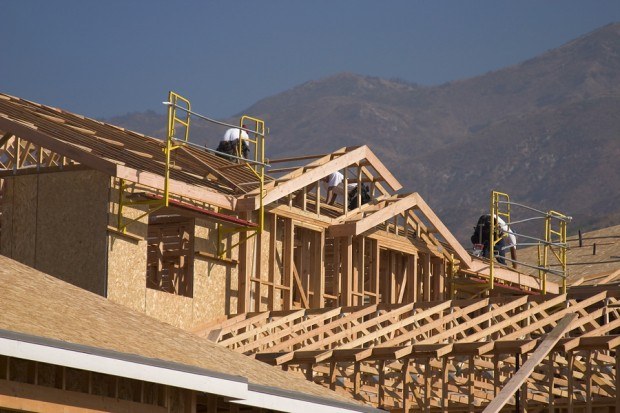A majority of U.S. homebuilders view conditions for new construction as favorable for the first time since the housing crisis began seven years ago, in one of the strongest signs yet that the U.S. housing recovery is on track.
The National Association of Home Builders/Wells Fargo Housing Market index, released on Monday, surged in June to register its biggest monthly gain since 2002.
A sharp rise in home prices, tighter inventories of properties up for sale and a slowing trend in foreclosures have all helped the housing market regain its stride over the past year, gradually brightening the outlook for builders. Even so, the jump in confidence this month was surprisingly robust.
“Much of this is somewhat just the way herd mentality works,” said Daren Blomquist, a vice-president at RealtyTrac, a real-estate research firm, referring to the index’s June surge.
“If I were to point to one key factor, it would be that average prices of existing homes have risen so dramatically over that past year to a level where homebuilders can once again viably compete with them in a broad range of markets.”
The closely watched index surged to 52 in June from 44 the previous month, handily topping forecasts. The index has risen 23 points from a year earlier.
Readings above 50 mean more builders see market conditions as favorable rather than poor. It was the first time the index has climbed above that dividing line since April 2006. The latest reading was also the highest since March of that year.
“We’ve definitely seen an upbeat sentiment among customers over really the whole of 2013 so far,” said Fred Cooper, spokesperson for Toll Brothers Inc., one of the largest U.S. homebuilders. “It reflects the strength of the pent-up demand and the confidence that buyers now have coming into the new home market.”
Flagging a more robust outlook for profits, the stronger-than-expected data buoyed homebuilder shares. The PHLX Housing Index closed 1.6 percent higher. Toll Brothers and Pulte Group Inc. gained more than 2 percent, while Lennar Corp rose 0.7 percent.
While the data helped homebuilder shares, investors were mostly focused on whether the Federal Reserve would reinforce its commitment to supporting the economic recovery at its meeting on Tuesday and Wednesday. The market wants clues from the Fed on when it would start cutting back on its $85 billion in bond purchases every month.
Those purchases have stimulated the economy and kept mortgage rates near record lows in recent years. While a recent spike in market rates has raised concerns about the headwinds that might pose to the recovery, home loans remain cheap by historical standards, a trend that bodes well for the market.
In addition, purchases of real estate by bargain-hunting investors have soaked up excess demand left in the wake of the housing market collapse, helping to prop up prices.
“It’s surprising that we didn’t see the confidence index jump earlier,” said Jed Kolko, chief economist at Trulia, an online real estate marketplace, citing the recent increase in building permits.
Homebuilders felt even more optimistic for the coming months, according to Monday’s report. A gauge of single-family sales expectations for the next six months accelerated to 61 from 52. The single-family home sales component rose to 56 from 48, while prospective buyer traffic climbed to 40 from 33.
But some homebuilders expressed some concern that the housing recovery could falter in the months ahead, especially with interest rates likely to keep rising.
“If interest rates climb, prices start getting high again, the market falls, it’s obvious what’s going to happen,” said Alan Wolff, owner of A.D. Wolff and Associates Inc., a custom homebuilder based in Golden, Colorado. “It was a perfect storm for the recovery.”
Builders could also encounter an additional hurdle if more homeowners and lenders that are holding inventories of foreclosed homes decide to put their properties up for sale.
“The one concern for homebuilders is if other existing home sellers and distressed sellers also decide that it’s a good time to sell, giving the builders more competition,” said RealtyTrac’s Blomquist.
Manufacturing Report
In a separate report, the New York Fed’s “Empire State” general business conditions index came in stronger than expected on Monday.
The index rose to a reading of 7.84 from minus 1.43 in May, topping expectations for zero. A reading above zero indicates expansion.
Even so, weakness in new orders and employment fell to their lowest in five months, indicating activity in the New York state manufacturing sector remained sluggish.
“Sentiment may be improving but actual output isn’t improving,” said Michelle Meyer, senior economist at Bank of America Merrill Lynch in New York.
“This report suggests manufacturing activity is sluggish and that we are seeing that in the U.S. and the rest of the world.”
While the housing recovery has been gaining traction, manufacturing activity has softened, hurt by belt-tightening in Washington and weaker demand overseas.
“Anything on the production side of the economy, including manufacturing, is falling back on the fundamentals. Right now the fundamentals, especially for the global picture, are still fairly soft,” said Sam Bullard, senior economist at Wells Fargo in Charlotte, N.C.
The most recent look at the sector on a national basis from the Institute for Supply Management showed manufacturing contracted in May to a four-year low.
Monday’s regional report poses the risk that ISM’s index could fall even further below the 50 mark when the June report is released at the beginning of next month, said Amna Asaf, economist at Capital Economics.
The economy overall is thought to have hit a soft patch in the second quarter and growth is forecast to slow from the 2.4 percent pace seen in the first three months of the year.





















 Hong Kong Fire Reveals Contractor Safety Breaches, Residents’ Revolt
Hong Kong Fire Reveals Contractor Safety Breaches, Residents’ Revolt  AI in Property/Casualty Insurance: Why Trusted Data Is the Missing Link
AI in Property/Casualty Insurance: Why Trusted Data Is the Missing Link  What to Expect in 2026: U.S. P/C Results More Like 2024
What to Expect in 2026: U.S. P/C Results More Like 2024  Chubb, The Hartford, Liberty and Travelers Team Up on Surety Tech Co. Launch
Chubb, The Hartford, Liberty and Travelers Team Up on Surety Tech Co. Launch 